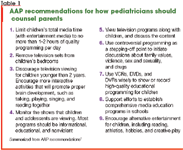Children and television: A primer for pediatricians
Television can have a powerful effect on children. If it is viewed as a tool, TV can exert a positive influence on its audience of children.
DR. CHRISTAKIS is an associate professor of pediatrics and director of the Child Health Institute in the department of pediatrics, University of Washington, and Children's Hospital, Seattle.
DR. ZIMMERMAN is an associate professor of health services, Child Health Institute and department of pediatrics, University of Washington, and Children's Hospital, Seattle.
They are the authors of The Elephant in the Living Room: Make TV Work for your Kids, Rodale, 2006.
When David Sarnoff, president of RCA, presented the newly invented medium of television at the New York World's Fair in 1939, he had grand visions. "Television," he proclaimed, would be "an art which shines like a torch of hope in a troubled world." Many would now question whether television has lived up to his grandiose dreams, but most would agree that the scale of those dreams is not misplaced: television is an enormous and growing presence in the lives of today's children.
Children spend an average of 3-6 hours per day with TV and other screen media.1-3 In 1961, the average age at which children began to watch television was 2.8 years; today it is 9 months.4 Whether it is infants watching the new 24-hour "Baby's First TV" channel or teenagers text messaging while they watch TV shows on their iPods, we are technologizing childhood in a way that is unprecedented.
The digital divide used to separate rich from poor; now it separates parents from their children.5 Adults are often clueless about the media-saturated world their children inhabit. And pediatricians have been accused of being clueless too.6 This article will attempt to summarize a few of the major effects television is believed to have on children across the age span.
Infant viewing

Since those guidelines were issued and summarily ignored, there has been a veritable explosion in video products targeting very young children. This is not surprising. The amount of television viewing in older children and adults had been largely static for decades; infants therefore represented a natural market extension. An enormous number of video products, and now at least one commercial cable channel, are directed at infants. Despite explicit and implicit claims to the contrary, these products have no demonstrated ability to make children smarter, more musical, or more mathematically inclined.9
In fact, the best available evidence, although far from conclusive, supports the academy's recommendation that viewing in this age group be discouraged. Early viewing (before age 3) has been associated with attentional and cognitive problems at school age.10,11 Even programs of proven educational benefit for 3- to 5-year-old children such as Sesame Street can delay language acquisition when viewed by younger children.12 Unfortunately, most parents are not aware of or discount these data. In a survey we recently completed, 29% of parents report that they believe that having their children watch infant videos is "good for their brains".4 Pediatricians must be prepared to countervail parental expectations of these products, and be ready to reinforce the value of traditional interactive play in this age group.13
Television and aggressive behavior
In 1968, five days after Robert F. Kennedy was shot, President Johnson appointed the National Commission on the Causes and Prevention of Violence. Its conclusion was that although there was no single cause for the rise in violence, the television industry should be careful about its portrayals of violence.